
Our Weather Station, and Our 2023 Weather Data
Hello friends,
With it now being the new year, I can now share the 2023 weather data from our home weather station. I like to track the weather each year, so I'm aware of trends like first and last frost date, snow, and also how much rainfall we're getting.
Up until March last year, I had been using nearby weather stations for our data, but when the two closest weather stations shut down, it was time to once again invest in a weather station of our own. We had a weather station when we lived in Wellington, but my husband accidentally smashed it when he chopped down a tree on our property (I did suggest before he chopped the tree down that we should move the weather station out of the way, but he said it would be fine...).
After much research last year we chose the Ecowitt GW1101 WIFI weather station, which has a 7-in-1 Outdoor Sensor Array: (wind vane, wind cups, UV / solar
radiation sensor, thermo-hygrometer sensor, and rain gauge), and a USB Wi-Fi Gateway. The WIFI gateway lets you import your weather data in a number of ways, and we chose to import the data onto our local server, and hubby made a local web interface for looking at the data. We also chose to add on a number of other sensors to the WIFI gateway, so we also have four soil water sensors, and a PM 2.5 air quality sensor. We currently have one soil sensor in our glasshouse, and the other three under each citrus tree we have. The air quality sensor is installed between us and our neighbour who has a very smoky woodburner. We have also just purchased two water leak detection sensors to add to our system, as we got a leak in our roof space last week, and had water coming down from our garage ceiling. We're going to place the sensors near our old hot water cylinder, and also near the garage in the roof space as an early warning system for the future.


We positioned our weather station in one of our vegetable garden beds, as it was away from lots of heat sinks like the house and concrete paving, and we reused the pole from our old TV aerial to mount it in place.
In this blog post, I will be sharing the general weather data that was collected during the 2023 year.
Yearly Weather Totals:
Lowest Temperature of the Year: The lowest temperature for the year was -6.8˚C, which happened on the 8th of June 2023. This temperature occurred during a week of heavy frosts, we had 7 days of no wind and clear nights. This temperature happened on the third day of frosts in that week. This frost was responsible for killing one tree, as all the leaf buds had been heavily damaged. This cold weather led to very high PM2.5 air quality readings in all of Mosgiel, and we had to have two air filters running inside the house to keep the air clean.
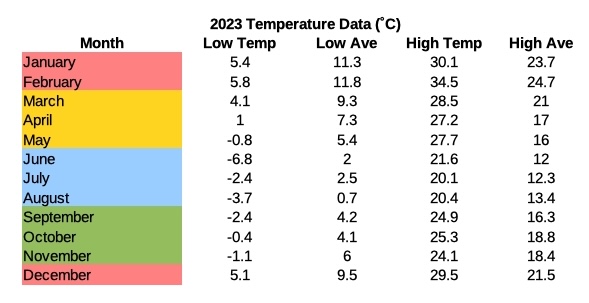
Highest Temperature of the Year: The highest temperature for the year was 34.5˚C, and this happened on the 2nd of February 2023. This happened on a summer day where we had strong North Westerly Foehn winds. This NWer Foehn wind set up is common in Dunedin before a Southerly arrives, and this can happen at any time of the year. NWers are common in winter just before a winter snow storm from Antarctica, so the temperature change can be quite drastic within a day.
Rainfall for the Year: This year we had a rainfall total of 931.4 mm rain. March was unexpectedly rainy, it's usually one of the driest months of the year in mid autumn. January 2023 was particularly sunny and dry, and we were on water restrictions until March.
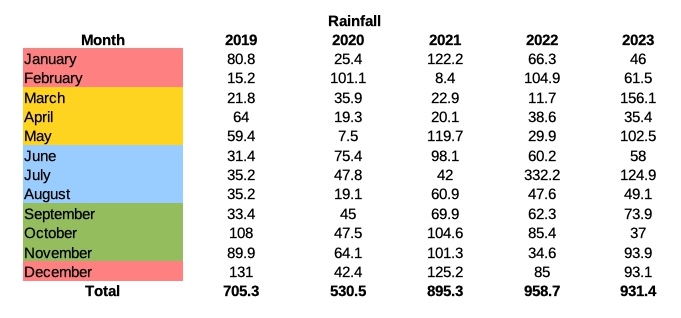
Frost Days: Here in Dunedin it's cold in winter, and we get a large number of frosts, which is good for killing off pathogens in the garden, and helping fruiting in trees and bushes like apricots, cherries, and blackcurrants. We had 38 frost days in 2023. The first frost was on 22 May 2023 and was -0.8˚C, and the last frost was on 10th November 2023 and was -1.1˚C. The last frost date was particularly terrible, as it was well past the date where it is assumed plants growing in the vegetable garden would be safe, and I lost many vegetable plants including beans and pumpkins. My grandad always told me it was safe to plant vegetable plants outside from Labour day weekend, and that's the date I use in planting frost tender plants. You can find an in depth blog post on the November frost here.
I've included other Frost Days in the years since we moved into our home. As you can see in general, the first frost is usually in May, and the last one in October. The last frost in November 2023 is an outlier.
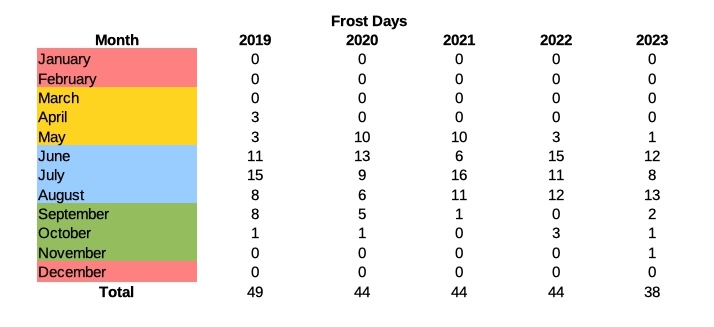
As another way of visualising the frosts in 2023, I've graphed out each instance of frost against time for 2023. There are distinct clumps of frost occurring throughout the year, and they usually happen after a southerly front has gone through.
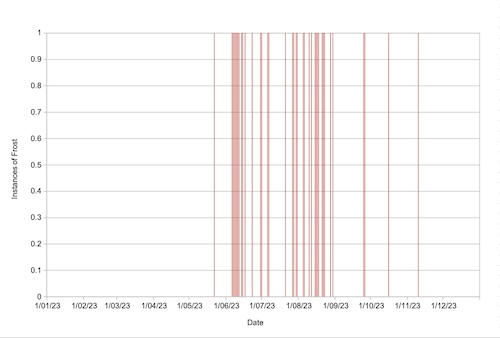
Snow Days: I count snow days as days that we have snow falling outside our home at our height above sea level (30 m), whether or not it may settle. Snow means that a big southerly storm has gone through, and this will lead to frosts afterward. In 2023, we had three snow days, two in July, and one in October. The one in October was very out of character, as usually we get snow events between July and September.
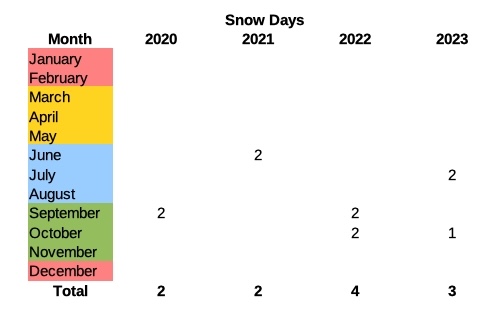
These are the most important factors I look at in interpreting the weather data, but there is much more I could look at, for example comparing frost and snow days verses days that NWers come in before a Southerly storm. 2024 will be the first year I will collect data on NW days.
Do you collect your own weather data for the year? I found it's very useful for in planning in the garden. There's lots of amateur weather stations available online to collect your own weather data, but if you're a big weather geek like me, it doesn't take long before deciding to get a weather station of your own.
Have a wonderful day.
Julie-Ann
Want to discuss my post? Feel free to chat with me on Instagram or Mastodon.




